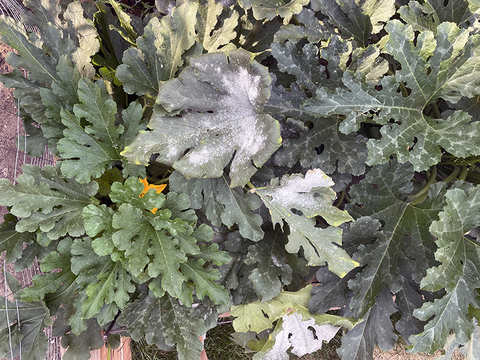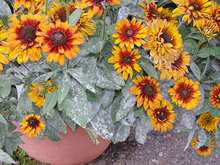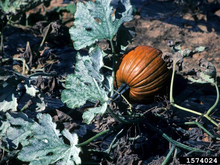How To Treat Powdery Mildew In The Garden During Harvest
- Home
- Yard and garden
- Yard and Garden News
- Powdery mildew in flowers and vining vegetables

While this dry growing season has limited the appearance of most plant diseases, diseases that aren't as dependent on water have still cropped up this year. This includes a group of common plant diseases that affect many garden plants — powdery mildew.
So, why do leaves look white and dusty?
Powdery mildew is a group of plant fungal diseases that cause the same symptoms across many plant groups. There are strains of powdery mildew that infect flowers and vining vegetables.
Across all groups, the disease appears as if leaves have been dusted with a thin layer of powdered sugar. This often starts on the underside of the leaves or as a singular dot here and there. The disease can then spread, causing whole leaves to take on a dull, white cast, then shrivel and die off.
Powdery mildew, unlike many other plant diseases, needs a minimal amount of water to take off. This means that even though we are in a drought, powdery mildew can become established on leaves and spread.
What do I spray to cure my plant?
A common misconception is that we can cure our plants when they catch a plant disease. No practices or products, be it from the pantry or a big box store, can cure an infected plant. There is no way to turn back time and make a leaf that is now diseased green again.
The best course of action for plant diseases is prevention. What course of prevention you choose depends on your garden goals.
I grow flowers for a beautiful garden, and now it's ugly. How do I save my flowers?

The lowest cost thing to do is to change your attitude. Powdery mildew only impacts the appearance of most of our ornamental and landscape plants.
If you have goals overall to grow naturally or organically, powdery mildew is just going to be part of having a Minnesota garden, and making peace with that can pay dividends for as long as you garden.
Try to train your eye to focus on the blooms (which powdery mildew rarely infects) instead of the foliage.
How much does powdery mildew matter in vining vegetables?

For pumpkins, squash, cucumbers and melons, we care much more about the fruit we harvest than the leaves. What you decide to do about powdery mildew this year depends on where your plants are at in their growth.
If you catch powdery mildew early, just remove infected leaves. Powdery mildew spores are present in the air, so removing a diseased leaf doesn't mean you won't see the disease again this year, but at least you are removing a source of new spores directly in your garden.
If the disease has progressed and entire leaves are dying off, take stock of where the plant is at. Maybe it is a zucchini plant that has produced heavily for a month. This plant is likely hitting the end of its natural life anyway, and it's time to just let the disease take its course and enjoy the last few summer squash of the year.
If you have other vining crops nearby that look healthy, you could remove infected leaves or remove the zucchini plant altogether to rid the garden of a source of powdery mildew spores.
I know my neighbors no longer answer the door when they see me coming up the walk with an armful of zucchini, so if that is your case, feel no guilt in getting rid of a powdery mildew infected plant. Especially as we still have time in the growing season for planting quick-growing radish or lettuces.
On the other hand, things like pumpkins and squash may still have a bit of growing to do. In some gardens, pumpkins and squash have turned color. If you have powdery mildew in these plants, it is a good idea to harvest any pumpkins or squash that are ready.
Powdery mildew can infect the handle in pumpkins, which makes for a less charming jack-o-lantern. If leaves are withering, leaving your pumpkins out can expose them to sunburn and pests like squash bugs. Take the squash to a protected spot, be it in shade or a basement, to wait for the Halloween and vegetable roasting seasons.
My garden is a big investment, how do I stop powdery mildew next year?
Here are some practices to start this year.
- Make sure you remove powdery mildew infected plant residue as it appears. You can safely add it to the compost pile or burn it (check burning restrictions in your area).
- Some practices start before you plant. When you are ordering seeds and picking out plants, look for powdery mildew resistant varieties. These varieties are available in many vining vegetables and some flower varieties and make a big difference.
- Test your soil. This will enable you to apply the right amount and right type of fertilizer to your garden. Plants that are over-fertilized produce a lot of foliage and become overly bushy and extra susceptible to powdery mildew. Applying the right amount of nutrition is a win for the environment and your wallet.
- As you plant and care for next year's garden, think about airflow as you lay out the garden. All plant diseases love the wet leaves that poor airflow provides. Space plants based on their mature size. Doing so not only reduces disease issues, but makes weeding easier, and allows more light to reach stems, producing better bloom and fruiting.
How To Treat Powdery Mildew In The Garden During Harvest
Source: https://extension.umn.edu/yard-and-garden-news/powdery-mildew-flowers-and-vining-vegetables
Posted by: dudleywainvis1959.blogspot.com

0 Response to "How To Treat Powdery Mildew In The Garden During Harvest"
Post a Comment